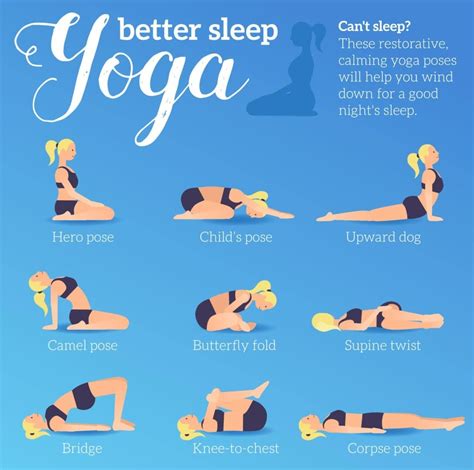4 Proven Yoga Practices for Better Sleep: Enhance Rest with These Techniques
Sleep deprivation can negatively impact both mental and physical health, leading many to seek natural solutions for better rest. Yoga, with its holistic approach to mind and body balance, has proven to be an effective tool for improving sleep quality. In this article, we’ll explore four distinct yoga types that can help you achieve better sleep, along with practical tips for implementing these practices into your nightly routine.
Introduction: Why Yoga for Sleep?
As stress and busy schedules take a toll on our ability to unwind, many people find it difficult to fall asleep or stay asleep throughout the night. Modern science increasingly supports yoga as an effective way to relax the nervous system, reduce insomnia, and improve sleep quality. In this guide, we will review Hatha Yoga, Yin Yoga, Nidra Yoga, and Restorative Yoga, each offering unique benefits for sleep enhancement. These yoga styles are easy to incorporate into a bedtime routine, even for beginners.
Key Concepts
- Relaxation Response: Yoga triggers the parasympathetic nervous system, calming the mind and reducing stress hormones, which can interfere with sleep.
- Body-Mind Connection: Slow, mindful movements, combined with deep breathing, signal to the body that it is time to rest and recover.
- Consistent Practice: Regular yoga sessions before bed help train the body to fall asleep more easily and stay asleep longer.
Historical Context: The Roots of Yoga for Sleep
Yoga has been practiced for thousands of years, originating in India as a comprehensive spiritual and physical discipline. Traditional texts, such as the Yoga Sutras of Patanjali, speak of yoga’s role in calming the mind and body. Over time, various styles have emerged that focus specifically on relaxation and stress relief, which are key components for improved sleep. Western adoption of yoga in the 20th century brought with it a growing focus on the physical and mental benefits of specific postures, breathwork, and meditation practices aimed at enhancing rest.
Current State Analysis: Sleep Problems in Modern Society
Today, about one in three adults suffer from some form of sleep disorder, whether it’s difficulty falling asleep, staying asleep, or achieving restful, restorative sleep. Overstimulation from technology, high stress levels, and irregular sleep patterns contribute to these issues. While many turn to medication for sleep, natural approaches like yoga are increasingly recognized for their ability to offer lasting benefits without side effects.
Practical Applications of Yoga for Sleep
Incorporating yoga into your bedtime routine can make a significant difference in your sleep quality. Let’s take a closer look at four types of yoga that are particularly beneficial for better sleep:
1. Hatha Yoga
Focus: Gentle stretching and breathing exercises to promote relaxation.
Why it helps: Hatha yoga is a slow-paced practice that allows the body to release tension built up throughout the day. The deep, controlled breathing calms the nervous system, signaling to the brain that it’s time to wind down.
How to use it: A 10-20 minute session of Hatha yoga before bed can ease physical tension, particularly in the back, shoulders, and neck, which are common areas of stress-related tightness.
2. Yin Yoga
Focus: Long-held poses designed to stretch deep connective tissues and release stored tension.
Why it helps: Yin yoga encourages deep relaxation by targeting the body’s deeper layers. Holding poses for several minutes helps quiet the mind and create stillness, which is essential for preparing the body for sleep.
How to use it: Yin yoga is best practiced in the evening to relax muscles and promote a meditative state. Spend 3-5 minutes in each pose, focusing on slow, deep breathing.
3. Nidra Yoga
Focus: A guided meditation practice that leads the body into a deep state of rest.
Why it helps: Also known as yogic sleep, Nidra yoga is a form of conscious relaxation that guides the practitioner through different layers of awareness. This practice is highly effective for reducing mental chatter and stress, making it easier to fall asleep.
How to use it: Nidra yoga can be done lying down in bed. Following a 20-40 minute guided Nidra meditation session can significantly improve sleep onset and overall quality.
4. Restorative Yoga
Focus: Relaxing postures using props to support the body in deep rest.
Why it helps: Restorative yoga allows the body to fully relax by using props like blankets and bolsters to hold poses comfortably for extended periods. This practice is ideal for calming the mind and soothing the nervous system.
How to use it: Practice restorative yoga for 20-30 minutes in a quiet, dim environment before bed. Focus on breathing slowly and deeply.
Case Studies: Real-Life Results from Yoga Practitioners
| Yoga Type | Practitioner Experience | Results |
|---|---|---|
| Hatha Yoga | A working professional with high stress levels used Hatha yoga before bed. | Reported a significant decrease in time to fall asleep and deeper, more restorative sleep. |
| Yin Yoga | An insomniac practiced Yin yoga for three weeks. | Noticed longer sleep durations and fewer instances of waking up during the night. |
| Nidra Yoga | A college student with anxiety began practicing Nidra yoga nightly. | Felt calmer before bed and reported more restful sleep without racing thoughts. |
| Restorative Yoga | A person with chronic pain integrated restorative yoga into their routine. | Found significant pain relief and slept more comfortably. |
Stakeholder Analysis: Who Benefits from Yoga for Sleep?
- Individuals with Sleep Disorders: People with insomnia, sleep apnea, or irregular sleep patterns can benefit from the calming effects of yoga.
- Health Professionals: Doctors and sleep specialists can recommend yoga as a non-invasive, holistic approach to sleep improvement.
- Mental Health Practitioners: Therapists and counselors may suggest yoga to clients dealing with stress, anxiety, or depression that disrupts sleep.
- Yoga Instructors: Teachers can design specific sleep-focused classes to meet growing demand for natural sleep aids.
Implementation Guidelines
To maximize the sleep benefits of yoga, follow these implementation guidelines:
- Choose the Right Time: Practice yoga 30 minutes to one hour before bed to give your body time to wind down.
- Create a Calm Environment: Dim the lights, reduce noise, and eliminate distractions to fully immerse yourself in relaxation.
- Stay Consistent: Incorporate yoga into your nightly routine for at least three weeks to see noticeable improvements in your sleep quality.
- Modify Poses as Needed: Use props like blankets or bolsters for comfort, especially if you have physical limitations or injuries.
- Combine with Other Relaxation Techniques: Pair yoga with breathing exercises, aromatherapy, or relaxing music to enhance the sleep-inducing effects.
Ethical Considerations in Yoga for Sleep
While yoga is a safe and effective practice for most individuals, it’s essential to consider ethical aspects, such as:
- Accessibility: Ensure that yoga for sleep is inclusive and adapted for people with varying physical abilities.
- Misleading Claims: Avoid overstating the benefits of yoga for sleep, especially for individuals with serious medical conditions.
- Commercialization: Be cautious of companies that exploit yoga as a sleep aid without offering authentic, well-researched programs.
Limitations and Future Research
While yoga has proven benefits for improving sleep, it’s not a one-size-fits-all solution. Individual differences, such as stress levels, medical conditions, and lifestyle factors, may influence how effective yoga is for sleep. Future research should explore:
- The long-term effects








